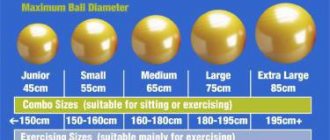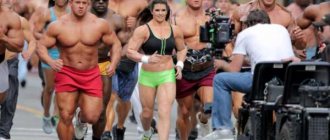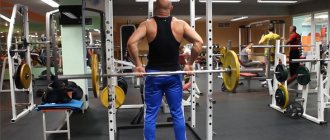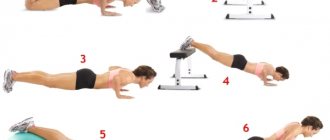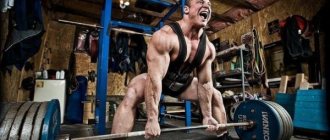Regular sports will help a teenager develop faster, feel more confident and strong. However, not all children know how to properly structure their activities, which can result in serious injuries.
To prevent this from happening, parents should enroll their child in a gym for teenagers so that a professional trainer controls the training process, which has many features. A set of exercises for a teenager should be selected taking into account his age.
Features of gym classes for teenagers
Starting from the age of 10-12, children’s bodies undergo dramatic changes: the skeleton actively stretches, the muscles cannot keep up with its growth, the load on the heart and blood vessels increases, the genitourinary system moves to another level, and hormonal changes occur.
Therefore, at this age, children are not in the best physical and psychological condition.
Correct exercises in the gym for teenagers will help correct the situation. After regular training, coordination of movements, physical fitness improves, and self-confidence increases.
Important! The coach should explain to the teenager that the main goal of the classes is not to pump up huge muscles, but to strengthen the body, accelerate its growth, and build a beautiful physique. Competent training in the gym will help prepare a teenager’s body for more serious loads (if he wants it).
If a teenager does not want to play sports, then it would not be a bad idea to tell him about the consequences of a passive lifestyle. This list includes excess weight, weakening muscles, disorders of the cardiovascular system, curvature of the spinal column, etc. If a teenager is dissatisfied with his body, then active sports in the gym will help solve this problem, make him more confident, sociable, and reduce the likelihood of injury.
In order for training to bring only benefits, a teenager must follow these recommendations:
- from 10 to 16 years old it is prohibited to perform exercises with additional equipment. During this age period, the child’s body is actively growing, and excessive physical activity can disrupt development. For this reason, children under 16 years of age should avoid deadlifts, squats, military presses, etc. Sports elements with your own weight will be quite enough;
- at the age of 12-15, it is prohibited to perform movements during which the spine is compressed and twisted: various variations of the bench press, squats with a barbell, dumbbell biceps curls, etc. This is due to the fact that the spinal column is forming, so the risk of injury or slowdown in natural growth is high;
- from 16-17 years old you can supplement the complex with exercises with sports equipment. The main thing is to start with a minimum weight, which does not exceed 10 kg;
- Any workout in the gym should begin with a warm-up, which will help warm up the body before training. If you exercise on cold muscles and ligaments, then the risk of injury is high;
- At first, the teenager should focus on the technique of performing the exercises. Once the body remembers how to move correctly, it will be possible to increase the load and pace;
- if training is aimed at increasing weight, then you need to move smoothly; for losing weight, a fast pace is more suitable (but not above average);
- the range of motion must be increased gradually to avoid injury and increase the effectiveness of exercise in the gym;
- It is important to learn to feel the tension of the muscle group being worked. The load should be especially high at the top or bottom point;
- a teenager must be able to fix his body and distribute the load on certain muscle groups;
Attention! For gym classes to be effective, a teenager must learn to breathe correctly. You need to take a deep breath and exhale while performing one repetition. Holding your breath is dangerous because it affects your blood pressure.
- the workout should not last longer than 60 minutes. Longer sessions can lead to exhaustion, decreased performance, risk of injury due to fatigue, and decreased alertness.
It is also important to choose the most suitable sports for a teenager, taking into account the characteristics of his physique, character, and health status. For example, weightlifting is allowed only from 16-17 years of age; up to this age it is allowed to do movements with one’s own weight.
Aerobic exercises (cardio) can be performed from 10 years of age. In the gym you can exercise on a treadmill, elliptical, or exercise bike; in addition, the trainer will be able to select effective exercises to strengthen muscles and improve the health of the body. Girls can choose step aerobics - this is a lightweight discipline that will help you lose weight, strengthen muscles, develop coordination and grace.
Be sure to check out:
Gallery image with caption: Losing weight in the gym: the dream or reality of every girl Gallery image with caption: Workout program in the gym for girls Gallery image with caption: How to use exercise equipment in the gym Gallery image with caption: Workout program for the gym for men : creating an effective set of exercises
Why do you need a charger for children?
It is important to understand the importance of morning exercises for schoolchildren. Children under 14 years of age experience intensive bone growth, mental and physical development. Therefore, it is very important for schoolchildren to devote some time a day to physical exercise. At the age of 14, puberty begins, boys build up and begin to develop faster than girls.
But it is worth considering that the cardiovascular system of schoolchildren is not yet fully developed. Fainting, jumps in blood pressure, and weakness during physical exertion often occur. But despite this, you should not cancel physical exercise; you can reduce its intensity.
Gymnastic exercises and exercises, on the contrary, help the child’s body adapt to changes and.
While mental stress prevails in a schoolchild, the body begins to get tired, and the immune system suffers first of all.
That's why it's so important to do exercises between studies. In addition, a schoolchild can harm his spine.
When children do exercises, all the muscles of the child’s body are strengthened.
It is very important to do morning exercises first, and also to load the child with physical labor in between classes.
A set of exercises for early adolescence
Children 10-14 years old can perform basic exercises with their own weight, and they are also allowed cardio exercise.
Carefully! A child from 11 years of age can use additional weight during exercise in the gym, but only under the supervision of a trainer and after the permission of a pediatrician who will assess his physiological condition.
The following complex for younger teenagers will help strengthen muscles, develop dexterity, coordination of movements, and increase endurance. It is recommended to conduct training 3 times a week with breaks so that the child’s body has time to recover. At the same time, 2 complexes are lighter, and one is heavier.
A set of exercises for teenagers 10-14 years old:
- Lesson No. 1 (easy):
- warm up on a treadmill - from 5 to 7 minutes;
- jump rope for 60 seconds three times;
- then do push-ups, pull-ups and squats 10 times with your body weight. Perform the complex 4 times with a break of 1.5-2 minutes. All exercises in the set must be performed without rest or with minimal break;
- raise your legs on the horizontal bar or do abdominal crunches – 8 to 10 times.
- Workout No. 2 (difficult):
- do a warm-up as in lesson No. 1;
- do burpees (jumping up from a lying position with a clap above your head), crunches, squats 10 times for 5 sets. One approach should be performed without breaks or with minimal pause;
- jump on the pedestal, do 9 push-ups, do 9 shuttle runs. Repeat the complex three times;
- perform reverse push-ups from the bench as many times as possible in 3 approaches;
- stand in the plank for 30-45 seconds three times.
- Lesson No. 3 (easy):
- warm-up as in previous workouts;
- do push-ups, pull-ups, squats 10 times for 4 sets;
- raise your legs on the horizontal bar – 10 times;
- stand in the plank – 45 minutes three times.
Each gym session should end with stretching for 5 minutes. A teenager should do static exercises to allow the body to calm down and cool down.
Peculiarities
Morning exercises or exercises are important and necessary at any age, which is why it is recommended for all family members. Each age group has its own exercises and training focus, but the benefits of physical activity are obvious. From birth, the child is prescribed massages and exercises to help the proper development of the small body; in some cases, exercise therapy for infants is prescribed. When a child becomes independent and can perform physical exercise without the help of a parent, there comes a period of time when you need to start doing exercises with him.
9 years is the age when the number of homework for a child seriously increases, and he has several times more to do. Exercise for children aged 10 is simply necessary, because not every parent can find the time and finances for their child to attend a sports section or engage in other types of active activities.
To compensate for the lack of physical activity, it is important to set aside at least 20 minutes a day to do a little warm-up with your teenager. Gymnastic exercises at this age should be selected no less carefully than at any other stage of the child’s development. At both 9 and 11 years of age, the body is actively growing, and the older the student becomes, the more intense all processes occur inside and outside his body.
This is the time that is considered optimal for dividing a set of exercises for girls and boys due to the difference in the rate of development of the body. In addition, due to the peculiarities of metabolic processes during puberty, it is important for girls to focus on those exercises that will correct their figure. During the period of active bone growth in boys’ bodies, it is necessary to help them relieve muscle discomfort and develop their muscles so that they have time to grow behind the bone tissue.
Physical exercises and exercises for children 9-12 years old are of enormous importance, so you should not neglect it, but try to participate in the child’s life and spend physical education with him.
Program option for late adolescence
Starting at the age of 16, teenagers can use additional weights during training, but they should not sacrifice technique and risk their health. It is important to start with minimal weights and gradually increase their weight.
Training program for teenagers 15-19 years old:
- Perform bench press 12 times three times.
- Do 14 dips for 3 sets.
- Do 10 pull-ups three times.
- Squat the barbell 12 times in 3 sets.
- Raise your legs while hanging on the horizontal bar 12 times three times.
This complex allows you to work out your entire body in 1 day. You need to perform all the elements in 1 set without a break or with a minimal pause. After completing each set, you can rest for 2 minutes. Trainings are carried out three times a week with breaks of 1-2 days.
Teenagers can also study using the split system:
- Lesson No. 1 – pumping up the chest and biceps:
- bench press the barbell – 8 times three times. Before each set, perform several repetitions with minimal weight;
- press dumbbells on an incline bench 8 times in 3 sets;
- do push-ups on the uneven bars (wide grip) – from 10 times three times;
- raise your legs while hanging on the bar - from 10 times for 3 sets;
- lift the barbell onto your biceps 8 times three times;
- Bend your arms on the Scott bench 8 times in 3 sets.
- Lesson No. 2 (pumping the back and triceps):
- perform deadlifts or Romanian deadlifts 10 times three times (2 warm-up sets);
- pull up 10 times four times;
- shrug your shoulders with a barbell in your hands (shrugs) – 10 times for 3 sets;
- do push-ups on the uneven bars - 10 times three times;
- Perform a French press with a barbell 8 times in 3 sets.
- Lesson No. 3 (working the legs and shoulders):
- squat with weights 10 times three times;
- perform the “Donkey Kick” exercise in the Smith machine – 15 times three times;
- press dumbbells while sitting – 10 times for 3 sets;
- press the barbell while standing – 10 times 3 sets;
- twist the body on the press - from 12 times three times.
It is recommended to perform all exercises in the gym smoothly, observing technique. Training takes place 3 times a week with breaks, this is enough for gradual muscle growth and strengthening of physical strength.
Approximate complex
In order for exercises and gymnastics for teenagers to proceed correctly, it is worth choosing the optimal exercises for them. The main ones will be:
- Walking in place. It is important to monitor the position of the torso, posture and the position of the arms - straight down.
- Feet together, arms along the body, Task: raising on toes, while arms should be raised simultaneously to the sides. It is necessary to monitor your posture and breathing.
- Feet slightly apart, bend your arms at the elbows in front of you. Task: rotate the torso alternately in each direction with maximum elbow retraction. It is important to monitor your posture.
- Legs, as in the previous exercise, place your hands on your shoulders. Task: rotate your elbows forward and backward at maximum amplitude. Watch your posture.
- Feet shoulder-width apart, arms down. Task: on count 1 – lean forward, extend your arms parallel to the floor, on count 2 – starting position. You can complicate the exercise: 1 – bend forward, 2 – bend in the back and arms up, 3 – bend forward, 4 – starting position.
- Squats to an angle of 90 degrees at the knees, move the pelvis back, keep your back straight with a slight tilt forward. To make it more difficult, you can do triple squats with three springs in each squat and return to standing.
- Feet slightly apart, arms down. Task: 1 – raising your arms and raising them on your toes, 2 – bending down and lowering your arms to the floor.
The number of repetitions will depend on the level of preparation of the children. As the exercises become feasible, you need to gradually increase their number.
You can also include exercises such as:
- Swing your legs.
Basic position: legs next to each other, arms freely. Swing the right and left legs for 8-10 repetitions. The movement is made from the starting position forward, to the side, and also backward with each leg in turn. - Coordination movements with arms and legs.
Feet side by side, arms down, on 1 – raising your arms and moving one leg back onto your toes, on 2 – starting position. We repeat the same with the other leg. - Bends to the sides with the addition of arms.
Feet slightly apart, hands on the waist. Task: tilt to the side, arms stretch in the same direction. The exercise is performed in each direction.
- Push ups.
Task: from a lying position, bend and straighten your arms at the elbow joint. Monitor the level position of the body and the range of movement. - Press.
Sitting on the mat, your legs can be straight or bent at the knee joints, and your hands can be positioned behind your head. Task: lie on your back and return to the starting position. You can add turns of the body to the right and left alternately to work the oblique abdominal muscles.
Using basic exercises or those that include elements of gymnastics for exercise with children 9-12 years old will be of great benefit to the body of adolescents, attract them to sports and give a good mood, preparing the student for a new day.
Recommendations from professionals
Experienced bodybuilders and professional trainers say that the easiest way to achieve an athletic and muscular body is during adolescence. From 13 to 18 years, the concentration of hormones that are responsible for muscle development is maximum. During this age period, guys' bone growth zones open up, making it easier for them to broaden their shoulders and strengthen their core.
However, according to professionals, doing weightlifting at too early an age is dangerous to your health. This is due to the fact that heavy projectiles can cause injury to the spine, joints, and disrupt overall growth. To prevent this from happening, strength training in the gym should be carried out no earlier than at the age of 16, and always under the guidance of a qualified trainer.
Until the age of 16, experts recommend performing basic exercises that help develop several muscle groups at once, but without weights. You can also exercise on the horizontal bar.
To increase the effectiveness of training in the gym, a teenager must eat right, follow a daily routine and not develop bad habits.
Boris Krasnov, coach
A professional trainer claims that up to the age of 16, it is better to perform basic elements without sports equipment. Such training will help strengthen the body, develop coordination of movements, increase endurance, and lay the foundation for further development.
Starting from the age of 16, a teenager can perform strength exercises, but the following recommendations must be followed:
- Practice the technique of performing fitness elements until it becomes automatic. And to do this, you need to contact a trainer who will tell you how to perform the exercise correctly and, if necessary, correct mistakes.
- Don't rush to increase the load. If the movement works, then it is better to consolidate the result at the next training, and only after that increase the load. Otherwise, injury may occur.
- Before performing the complex in the gym, be sure to warm up to warm up your muscles and ligaments.
- Watch your diet. 2 hours before going to the gym, it is recommended to eat, for example, porridge or muesli. After training, the teenager should eat for 40 minutes. For this purpose, foods rich in proteins (poultry, dairy products) and complex carbohydrates (whole grain products) are suitable.
B. Krasnov advises not to get carried away with sports supplements, which are useless for beginning athletes. Teenagers get enough nutrients from food.
Anna Moroz, trainer
According to an experienced trainer, almost all strength exercises that are performed with sports equipment (barbell, weights, dumbbells) place a strong load on the not yet fully formed spine and bone joints.
Then the risk of bending or deformation of bone structures increases. Therefore, the specialist does not recommend performing deadlifts or squats with a barbell before the age of 16. Teenagers in the gym can do exercises without additional weight or use special machines.
Teenagers under 16 years of age are recommended to visit the pool to strengthen the body and prepare it for further stress. You can start training in the gym no earlier than 16 years old and always under the supervision of a trainer. It is better to start performing power elements with dumbbells. You can start full-fledged training using a barbell when you are 18 years old.
It is recommended to supplement classes with proper nutrition, proper rest and taking vitamin and mineral complexes.
Irina Markina, coach
A fitness specialist claims that the main goal of a teenager working out in the gym is to strengthen the body and accelerate its growth. To do this, you need to perform basic elements that help develop several muscle groups at once. Isolated movements can be used to supplement the main loads.
Until the age of 16, the most natural exercises are the ones performed with your own weight. They harmoniously load the entire body without singling out individual muscle groups.
Weightlifting will be effective for a teenager only after his skeleton gets stronger and his body’s growth stops. If a teenager does strength training before the age of 16, the risk of injury to the spine and joints increases.
If a teenager wants to lose weight, then basic exercises need to be supplemented with cardio exercises. In addition, it is necessary to follow a diet that should include proteins, complex carbohydrates, vitamins and minerals, fiber, and some healthy fats. You should avoid fast food, fatty, fried foods, sweets and other unhealthy foods.
How to start morning exercises?
Another problem can be a child’s sedentary lifestyle and, as a result, postural curvature. To prevent this, monitor the position of the children’s bodies.
Watch the following video in which a schoolchild, under the guidance of an adult, performs a set of exercises to prevent poor posture as a result of a sedentary lifestyle.
Man, through his entire evolution, is programmed to move a lot
This is especially noticeable in small children who have not yet been spoiled by TV and computers: they always want to run, jump, climb...
It is more difficult with school-age children, since school and modern entertainment (computer, TV, DVD) teach them an exclusively sedentary lifestyle. Meanwhile, pediatric physiologists warn: a growing body needs to move at least 10 hours a week! Thus, nature intended a preschool child to play outdoor games 3.5-4 hours a day, a child 7-9 years old - about 3 hours, and children over 10 years old - 2.5 hours. It is ideal to do this outdoors.
Main conclusions
In order for a teenager to benefit from gym classes, his parents and he himself must follow the following recommendations:
- Until the age of 16, a teenager should train without using additional weight. When using sports equipment, the risk of slow growth and injury to the spine or joints increases.
- After 16 years of age, a teenager can include movements using sports equipment in the complex.
- Classes in the gym should be supervised by a professional trainer.
- Before performing the complex, a warm-up is required, and after it is completed, stretching is required.
- Training can be done 2-3 times a week with a break of 1-2 days to restore the body.
- It is important to immediately master the technique and then increase the load.
- The movements must be performed smoothly and the tension of the target muscles must be felt.
- The amplitude must be increased gradually.
- While working out in the gym, you need to breathe properly.
- The training cannot last longer than 60 minutes.
- The decision on choosing a suitable sport and complex is made by the coach together with the teenager, as well as his parents.
By following these rules, your child will be able to develop harmoniously, avoid injury and prepare the body for higher loads.
Exercises to lose weight
There are several reasons why a teen might be interested in taking a fitness class.
- Gaining muscle mass. As a rule, young men are interested in this. They strive to look strong and mature.
- Losing excess weight. In many cases, girls are more interested in this. However, there are also guys who suffer from excess weight.
Training for teenagers who want to get rid of extra pounds consists of aerobic exercise. It is this kind of fitness that allows you to launch the mechanism of burning fat in the muscles. Aerobic exercise includes Pilates, sports ballroom dancing, cycling, any active sports in a team, etc.
There are a large number of different exercises on the Internet specifically for teenagers. But this is not a good idea for training. 12 years is a difficult period, and a training program should be selected based on the physical characteristics of a particular child. At the same time, you cannot force him to do it, he must want it himself. Therefore, the best option would be to choose an active sport that will be interesting to him.
At what age can you do fitness?
If previously playing sports was the privilege of adults, now children’s and teenagers’ fitness is a fashionable trend. In the gym, children can do yoga, Pilates, strength training in a group or with a trainer. Moreover, individual lessons are recommended up to 14 years of age, because from this age a teenager can attend classes on an equal basis with adults.
From the age of 16, a child can begin independent training. However, it is worth remembering that at this age the skeletal system is strengthening, so intense strength training can lead to delayed development or injury. Due attention from parents will help avoid this. In return, your child will receive a lot of benefits from regular exercise:
- Increased flexibility and endurance.
- Improved coordination.
- Strengthening tendons and ligaments.
- Prevention of cardiovascular diseases and ARVI.
- Increased self-esteem.
- Positive attitude and development of healthy lifestyle habits.
The main thing is that fitness brings pleasure, and exercises are not a burden. Therefore, it is important to choose the right type of physical activity, focusing on the child’s preferences, his state of health and body type.
What you need to know before starting classes
Any type of fitness immerses a teenager in “adult” emotions, taking up part of his free time. Therefore, you should prepare for such a step. Eg:
- When enrolling a teenager in a fitness club, do not force your opinion on him. Instead, it is better to recommend a section to him, and the choice should be his.
- Consult a physician if your child has a chronic illness.
- Buy beautiful and comfortable sportswear and sneakers. Moreover, for girls, this approach will be an additional incentive not to miss classes.
- If a teenager needs to lose weight, then exercise should be accompanied by dietary control from parents.
- Buy a family membership and go to the gym together. Your personal example will become an additional incentive and pride for the child.
If a teenager decides to quit classes, consult with a coach to clarify the situation. Maybe it’s just fatigue that you need to endure by taking a break for a week, or it’s “burnout”, and the time has come to change the type of activity.
State Budgetary Institution "FSO "Youth of Moscow" Moskomsport (VAO)
Address : metro station Elektrozavodskaya, Barabanny Lane, 4/4 Website : https://www.ynmos.ru Telephone Cost : on request
The history of the Olympic reserve sports school "Youth of Moscow" in wrestling begins in 1954 with the Moscow city club "Spartak", where the first freestyle wrestling sports section was opened.
The school is developing a freestyle wrestling department. Over the entire period of operation of the school, where 714 athletes are trained, 11 Masters of Sports of Russia, 6 Masters of Sports of Russia of international class, 2 Honored Masters of Sports of Russia, a large number of winners and prize-winners of the Olympic Games, World and European Championships were trained.
Of the 24 coaching staff, 11 are honored coaches of Russia.
The Olympic Reserve Sports School accepts boys and girls from 10 years of age who are citizens of Russia, living in Moscow, and who have no medical contraindications.

